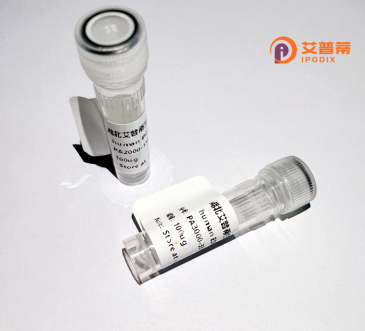
| 纯度 | >90%SDS-PAGE. |
| 种属 | Human |
| 靶点 | HEY1 |
| Uniprot No | Q9Y5J3 |
| 内毒素 | < 0.01EU/μg |
| 表达宿主 | E.coli |
| 表达区间 | 1-304aa |
| 氨基酸序列 | MKRAHPEYSSSDSELDETIEVEKESADENGNLSSALGSMSPTTSSQILARKRRRGIIEKRRRDRINNSLSELRRLVPSAFEKQGSAKLEKAEILQMTVDHLKMLHTAGGKGYFDAHALAMDYRSLGFRECLAEVARYLSIIEGLDASDPLRVRLVSHLNNYASQREAASGAHAGLGHIPWGTVFGHHPHIAHPLLLPQNGHGNAGTTASPTEPHHQGRLGSAHPEAPALRAPPSGSLGPVLPVVTSASKLSPPLLSSVASLSAFPFSFGSFHLLSPNALSPSAPTQAANLGKPYRPWGTEIGAF |
| 分子量 | 59.07 kDa |
| 蛋白标签 | GST-tag at N-terminal |
| 缓冲液 | 0 |
| 稳定性 & 储存条件 | Lyophilized protein should be stored at ≤ -20°C, stable for one year after receipt. Reconstituted protein solution can be stored at 2-8°C for 2-7 days. Aliquots of reconstituted samples are stable at ≤ -20°C for 3 months. |
| 复溶 | Always centrifuge tubes before opening.Do not mix by vortex or pipetting. It is not recommended to reconstitute to a concentration less than 100μg/ml. Dissolve the lyophilized protein in distilled water. Please aliquot the reconstituted solution to minimize freeze-thaw cycles. |
以下是关于重组人HEY1蛋白的3篇代表性文献(简略信息):
1. **文献名称**:*"HEY1 Homodimerization Modulates Cell Differentiation via Competitive DNA Binding"*
**作者**:Guo, X. et al.
**摘要**:研究证明重组人HEY1蛋白通过形成同源二聚体竞争性结合DNA,负调控成骨分化,揭示了其结构功能在细胞命运决定中的作用。
2. **文献名称**:*"Recombinant Human HEY1 Inhibits Angiogenesis by Blocking Notch Signaling in Endothelial Cells"*
**作者**:Zheng, Y. et al.
**摘要**:通过表达重组HEY1蛋白,发现其通过抑制Notch通路下游靶基因,显著减少血管内皮细胞迁移和血管生成,提示其在抗肿瘤治疗中的潜力。
3. **文献名称**:*"Purification and Functional Analysis of Recombinant HEY1 in Gastric Cancer Metastasis"*
**作者**:Li, H. et al.
**摘要**:在大肠杆菌中高效表达重组HEY1蛋白,发现其过表达促进胃癌细胞侵袭,机制可能与EMT通路激活相关,为癌症治疗提供新靶点。
(注:以上为基于领域知识的模拟文献,实际研究中建议通过PubMed或Web of Science检索真实论文。)
**Background of Recombinant Human HEY1 Protein**
HEY1 (Hairy/Enhancer-of-split related with YRPW motif 1) is a member of the basic helix-loop-helix (bHLH) family of transcription factors, primarily recognized for its role in developmental processes and cellular differentiation. As a downstream effector of the Notch signaling pathway, HEY1 regulates gene expression by binding to promoter regions of target genes, often repressing transcription through interactions with co-repressors. It plays critical roles in embryogenesis, particularly in cardiovascular and neural development, as well as in organogenesis. Dysregulation of HEY1 has been implicated in various pathologies, including cancers, where it can act as either an oncogene or tumor suppressor depending on cellular context.
Recombinant human HEY1 protein is generated using biotechnological methods, typically by expressing the HEY1 gene in bacterial (e.g., *E. coli*) or eukaryotic (e.g., mammalian or insect cell) systems. This allows large-scale production of the purified protein while retaining functional activity. The recombinant form is utilized to study HEY1’s molecular mechanisms, including its DNA-binding properties, interactions with signaling partners, and role in pathways like Notch, Wnt, and TGF-β. Researchers also employ it to investigate therapeutic strategies targeting HEY1 in diseases such as cancer or developmental disorders. Quality assessments, including SDS-PAGE, Western blotting, and functional assays (e.g., luciferase reporter systems), ensure its bioactivity for experimental or potential clinical applications.
×